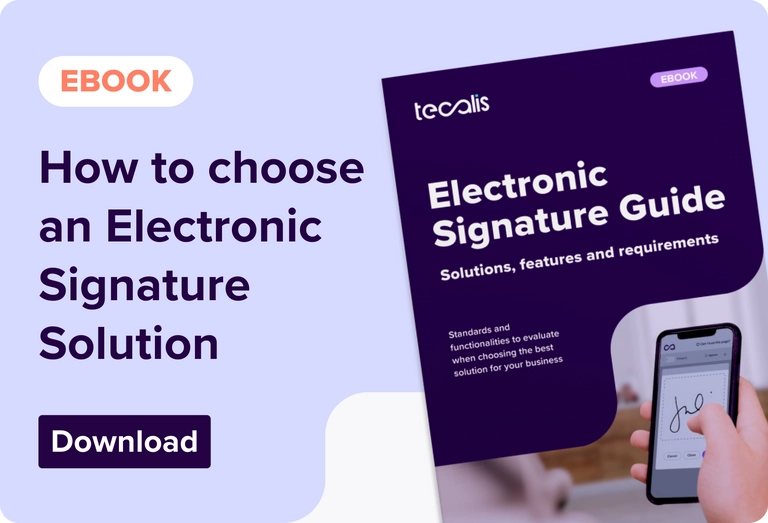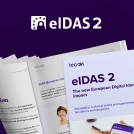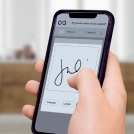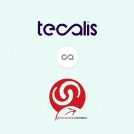Index
Get the latest news right in your inbox
Certified email is an agile and secure method for sending reliable notifications with relevant information. Email is already a part of our daily life, whether for personal and less important communications or for relevant procedures at work or with administrations.
However, with the rise of instant messaging services, which accumulate hundreds or thousands of messages per day for users, emails now stand out for their use for important business, professional or administrative communications.
Despite its practicality and speed, simple e-mail has certain limitations in terms of delivery guarantee, verification of the sender's identity and the legal validity of the messages, which is why certified e-mails are preferred.
To overcome these small but crucial limitations, certified email, also known as registered email or legally-biding mail, makes use of encryption and traceability technologies to ensure a legal acknowledgement of receipt. Below we will see what a certified email is, how a registered email can be sent in such a way that it is legal and the most relevant free certified e-mail platforms.
What is a certified email
A certified email is a type of email that incorporates advanced security and traceability mechanisms that allow the sender to verify its sending, reception, content and the identity of the sender and the reader. These features and functionalities provide certified emails with full legal validity if they are sent through a trusted regtech service provider, making it an ideal tool for communications that require legal guarantees in various fields.
In essence, the certified email works as a reliable proof of electronic communication, similar to what happens with the burofax in the traditional postal field, or certified mail. In this way, registered mail is an evolution of traditional email, designed to offer an additional layer of security, authenticity, immediacy and traceability in electronic communications.
Unlike a conventional email, which can be susceptible to tampering or spoofing, a certified email uses advanced technologies to ensure the integrity of the message and the identity of the parties.
This type of certified email not only focuses on the delivery of the message, but also provides reliable proof of receipt that can be used in the event of a legal dispute, thus ensuring a more reliable and secure communication between the parties involved.
When you send a certified email, you are using advanced encryption, blockchain and digital signature techniques to ensure that the message reaches its intended recipient securely and that its content has not been altered along the way. In addition, certified email provides a detailed record of the delivery of the message (via an audit trail document stamped by a trusted third party), the recipient's reading and any actions taken with respect to the email.
The certified email service is simple to use and highly economical, with cost savings of over 90% compared to traditional registered mail. Wherever and whenever you want, you can instantly obtain legal evidentiary validity by sending a certified email including attachments, for example.
Registered email: what it is and how it works
A registered email is and its operation is based on the intervention of a trusted third party, also known as a certification service provider or certification authority. This third party acts as guarantor of the identity of the sender, the content of the message and the date and time of sending and receiving, in addition to providing all the technologies and tools to be able to send the registered email.
In this way, we can understand that a certified e-mail is also a reliable e-notice. This standard is regulated by official bodies such as the European Union in its eIDAS regulations, as well as by counterpart organizations in other countries around the world, with the characteristics varying by region but being practically identical.
The process of sending a certified email usually includes the following aspects and steps:
- Tools and technologies in the digital service provider's platform: The sender accesses the platform of the selected certification service provider, which includes systems such as time stamping or digital signature.
- Creation of the certified email: The sender composes the email as he would do with a traditional email, attaching the necessary files if necessary and even attaching documents to be signed by electronic signature.
- Digital signature of the email by the sender of the email: The sender digitally signs the email using a digital certificate issued by a QTSP trusted certification service provider or through other identification methods provided in standards such as eIDAS and provided by the RegTech provider.
- Sending the certified email to the recipient of that communication: The digitally signed email is sent to the certification service provider's server.
- Verification and sending to the recipient by the trusted third party: The certification service provider verifies the digital signature of the sender, the content of the email and the date and time of sending. If everything is correct, the email is sent to the recipient.
- Notification of receipt: The recipient receives notification of receipt of the certified email, along with an acknowledgement confirming the date and time of receipt.
- Traceability of registered e-mail: An audit report is extracted with all the evidence of the process, which can be generated at any time and include information such as reception or even reading. This guarantees the non-repudiation of the received message. Metadata such as IP addresses, dates, times and all kinds of hard evidence are included.
Certified email is a very similar method to certified SMS. In terms of technology and tools, they work in a practically identical way, simply changing some technical aspects derived from the communication channel (telephone line or Internet messaging system).
But equally, the operation of a registered email is based on the use of digital certificates and security protocols. When you decide to send a certified email, the process starts with the digital signature of the message by the sender. This digital signature acts as a kind of "seal" that verifies the identity of the sender and guarantees the integrity of the email content.
Once digitally signed, the message is sent through secure servers that use end-to-end encryption to protect the information during its transit through the network. When it reaches the recipient, the certified email can be opened with complete security, guaranteeing that the content has not been altered and that it comes from the verified sender.

The legal validity of a certified email
The legal validity of a certified email is a crucial aspect; being basically what distinguishes it from conventional emails for practical purposes. In many countries (practically all), the laws and regulations on electronic communications and digital signature recognize the legal validity of certified emails with digital signature.
This means that a digitally signed certified email has the same legal validity as a physically signed document or the well-known traditional standard bureaufax via certified mail or registered letter. In case of legal or commercial disputes, the detailed record of the delivery and reading of the registered email can be presented as evidence to the competent authorities, providing solid legal support for the parties involved.
For a certified mail to be legally valid, it is essential that digital certificates and encryption technologies from recognized certification authorities (QTSP) are used and that detailed records are kept of the delivery and receipt of the message (audit trail).
In the case of countries such as Spain, for example, the legal validity of a certified email is covered by Law 59/2003, of December 19, 2003, on electronic signatures (which is much earlier than eIDAS), which establishes that an email data message sealed with certified electronic means shall have the same value and effectiveness as a handwritten signature in relation to the data contained therein.
In this sense, the Supreme Court has endorsed in several rulings the legal validity of certified email as a means of evidence in legal proceedings, provided that the requirements established by law are met by RegTech providers, such as the use of a valid digital certificate and the correct digital signature of the message.
Emails and digital certificates
On platforms such as Tecalis, digital certificates can be used to send certified emails. With the platform's integrated digital certificate manager, registered emails are quickly sealed and comply with the most stringent regulations. However, for those who do not wish to use their digital certificate by email or mail, they can opt for other methods and send a certified email with full legal validity in the same way.
To ensure maximum reliability and security in your electronic communications, it is essential to use a qualified trusted service that offers registered and digital mails with and without digital certificate by mail. These services are usually accredited by recognized bodies and comply with international security and privacy standards, such as the General Data Protection Regulation (GDPR), eIDAS, eIDAS 2 and DORA in the European Union (Regulation (EU) No. 910/2014 of the European Parliament and of the Council).
By opting for a qualified trust service, you not only benefit from the additional guarantees of security and legal validity (with document evidence in PDF or other formats), but you also ensure interoperability with other services and platforms as well as with other countries or regions, facilitating the management and tracking of your certified communications, whether you use the digital certificate in email or opt for another method validated by the QTSP.
Qualified trust services are subject to strict security and control requirements by the competent authorities, which guarantees the reliability of the digital certificate in the email and of the certified email services provided.
Certified emails uses: examples and applications
Certified emails have a wide range of uses in different fields and sectors, both in the public and private sectors. Here are some examples and practical applications of registered email:
- Formal, legal and judicial notifications: Dismissals, claims, summons, etc. Legal and judicial notifications, such as subpoenas or summons, can be sent as certified emails to guarantee their delivery and legal validity. It can also be used to give legal authorizations to third parties including all types of electronic signatures or to communicate the registration in delinquent files.
- Contractual communications and commercial agreements: Signing of contracts, agreements, modifications, cancellations, credit concessions, etc. Contracts and commercial agreements can be sent as certified emails to ensure receipt and acceptance by all parties involved.
- Financial transactions: Invoices, receipts, statements of account, payment receipts, tracking of shipments, allegations and pleadings, file notifications, etc.
- Communications with the administration: Submissions of applications, appeals, notifications, etc. Sending government communications, identification documents, certificates and other official documents that require validation and security.
- Internal and External Corporate Communications: In the corporate environment, certified emails are useful for internal and external communications that require a high degree of security and confidentiality.
Depending on the use case of the certified e-mail, different traceability options must be chosen to generate proof: reception, opening, viewing of documents, opening of documents, downloading of documents, etc.


How to send a certified email
The process of sending a certified email may vary depending on the service provider you choose. In order to send a registered email you must first choose the one that complies with the legal requirements established in the jurisdiction where you operate. There are some platforms that are simpler than others, but generally the method to send a certified email consists of the following steps:
- Access the platform of the certified email service provider: Select a trusted certification service provider and access its online platform by logging in with your account.
- Import a digital certificate to send by email or make use of the RegTech platform method: Create or import a valid digital certificate that will be used to digitally sign your emails or use a valid digital signature method provided by your trust service provider.
- Compose the email or attach a document with the information to be sent: Compose the email as you normally would, including any necessary documents or attachments. You can make a digital signature request for documents if necessary.
- Choose the sending method: Before sending the email, you can choose between sequential, bulk or parallel sending in case you have more than one recipient.
- Send the registered email: Once digitally signed, send the email through your provider's email service.
- Add the recipient's information: Enter the email address of the recipient to whom you want to send the certified email and all the information you consider or choose them from your address book.
- Store certified email delivery receipt and read receipt: Store the delivery receipt and read receipt of the registered email (audit report) as proof of sending and receiving.
Sending a certified email requires following a specific process to ensure the security, authenticity and traceability of the message. These notifications provide a reliable confirmation that the message has been delivered to the recipient and, if applicable, that it has been opened and read.
Free certified email tools
If you are looking for free options to send certified emails, there are some tools available that offer this functionality for free but it is important to note that while these tools offer flashy options, some advanced features or additional services may not be available. Always opt for a qualified and trusted service provider or your certified email will not have sufficient legal validity.
Tecalis Sign has both a free trial period that includes free certified email and a freemium version with a number of free deliveries. Although these tools tend to offer basic features and limitations compared to the paid versions, they can be an excellent option for individual users or small businesses looking to try registered email without incurring additional costs but with the legal backing necessary for certified email, unlike those online with dubious legal support.
Once your business grows and needs more, you can change your plan and use free certified mail included with your subscription or opt for another model at a very low cost. It is advisable to evaluate your specific needs and consider investing in a paid version if additional functionalities are required, as they provide an absolutely differential improvement at a really affordable price.

Advantages of registered e-mails
The advantages of using certified email are numerous and range from security and privacy to legal validity and operational efficiency. The use of certified emails offers several advantages over traditional email, bureaufax as registered mail or registered letters, especially in terms of security, traceability and legal validity. Some of the main advantages include:
- Increased security and privacy: Certified emails use encryption and digital signature to protect your electronic communications against unauthorized access and alteration. It ensures that the content of the email has not been modified or read during transmission.
- Instant legal validity and international recognition: Certified digitally signed e-mails are legally valid and internationally recognized, facilitating the acceptance and recognition of your communications in different jurisdictions.
- Detailed record and absolute guarantee of delivery: registered emails provide a detailed record of the delivery of the message, the recipient's reading and any action taken with respect to the email or certified mail, offering complete traceability of your communications.
- Ease of use and compatibility: Sending a certified email is a simple process that integrates easily with your existing email tools and platforms, ensuring a smooth and seamless user experience.
- Cost and time reduction: By facilitating the management and tracking of your electronic communications, certified emails contribute to the reduction of costs and time in administrative and legal processes, optimizing the operational efficiency of your business or professional activity.
- Professionalism and agility: The use of registered e-mail conveys an image of professionalism and seriousness, especially in business and commercial environments where security and reliability are fundamental aspects.
In summary, with a wide range of uses and applications and a series of significant advantages, certified mails become a fundamental tool for any type of electronic communication that requires guarantees of security, traceability and legal validity. Its use extends to various fields, both in the public and private sectors, providing confidence and security in digital communications.
Certified email has established itself as an indispensable tool in today's digital environment, offering security, legal validity and trust in electronic communications. With the tools and services available in the market, sending registered emails is easier and more affordable than ever with paid tools and free certified email, providing an effective and reliable solution to ensure the integrity and authenticity of the messages sent.































